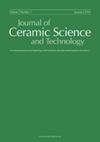反应热压TiB2-SiC-Ni陶瓷复合材料的力学性能及强化增韧机理
IF 0.4
4区 材料科学
Q4 MATERIALS SCIENCE, CERAMICS
引用次数: 6
摘要
采用反应热压法制备了具有高抗弯强度和断裂韧性的TiB2-SiC-5 wt %Ni陶瓷复合材料。采用不同的烧结时间和烧结温度。对其强化和增韧机理进行了详细的研究。采用x射线衍射(XRD)、扫描电子显微镜(SEM)、透射电子显微镜(TEM)和能谱仪(EDS)对其组成和微观结构进行了研究。烧结时间和烧结温度对复合材料的力学性能和显微组织有显著影响。随着烧结时间从30 ~ 45 min的延长,材料的力学性能逐渐降低,随着烧结时间的延长,材料的力学性能逐渐提高。随着烧结温度的升高,复合材料的力学性能逐渐提高。在所研究的参数范围内,在1700℃、30 min条件下制备的复合材料具有最佳的综合力学性能,抗弯强度为1121±31 MPa,断裂韧性为7.9±0.58 MPa⋅m1/2,硬度为21.3±0.62 GPa。复合材料抗弯强度和断裂韧性的提高主要是由于Ni和TiB2晶粒的强化增韧作用、晶内纳米颗粒结构以及位错和层错的形成。清洁的界面也有利于抗弯强度的提高。本文章由计算机程序翻译,如有差异,请以英文原文为准。
Mechanical Properties, Strengthening and Toughening Mechanisms of Reactive-Hot-Pressed TiB2-SiC-Ni Ceramic Composites
A TiB2-SiC-5 wt %Ni ceramic composite with high flexural strength and fracture toughness was fabricated in the reactive hot pressing (RHP) process. Different sintering times and sintering temperatures were employed. The strengthening and toughening mechanisms were investigated in detail. The composition and microstructure were investigated by means of X-ray diffraction (XRD), scanning electron microscopy (SEM), transmission electron microscope (TEM) and energy-dispersive spectroscopy (EDS). The sintering time and sintering temperature had a significant influence on the mechanical properties and microstructure of the composite. The mechanical properties decreased as the sintering time was increased from 30 to 45 min, and subsequently increased with the further increase of the sintering time. The mechanical properties of the composite increased gradually as the sintering temperature increased. For the investigated range of parameters, the composite prepared at 1700 °C for 30 min had the optimum comprehensive mechanical properties with flexural strength of 1121 ± 31 MPa, fracture toughness of 7.9 ± 0.58 MPa⋅m1/2 and hardness of 21.3 ± 0.62 GPa. The improved flexural strength and fracture toughness of the composite were attributed to the strengthening and toughening effects of Ni and the elongated TiB2 grains, the intragranular nano-particle structure, and the dislocations and stacking fault. The clean interface is also conducive to the improved flexural strength.
求助全文
通过发布文献求助,成功后即可免费获取论文全文。
去求助
来源期刊

Journal of Ceramic Science and Technology
MATERIALS SCIENCE, CERAMICS-
CiteScore
0.80
自引率
0.00%
发文量
0
期刊介绍:
The Journal of Ceramic Science and Technology publishes original scientific articles on all topics of ceramic science and technology from all ceramic branches. The focus is on the scientific exploration of the relationships between processing, microstructure and properties of sintered ceramic materials as well as on new processing routes for innovative ceramic materials. The papers may have either theoretical or experimental background. A high quality of publications will be guaranteed by a thorough double blind peer review process.
 求助内容:
求助内容: 应助结果提醒方式:
应助结果提醒方式:


